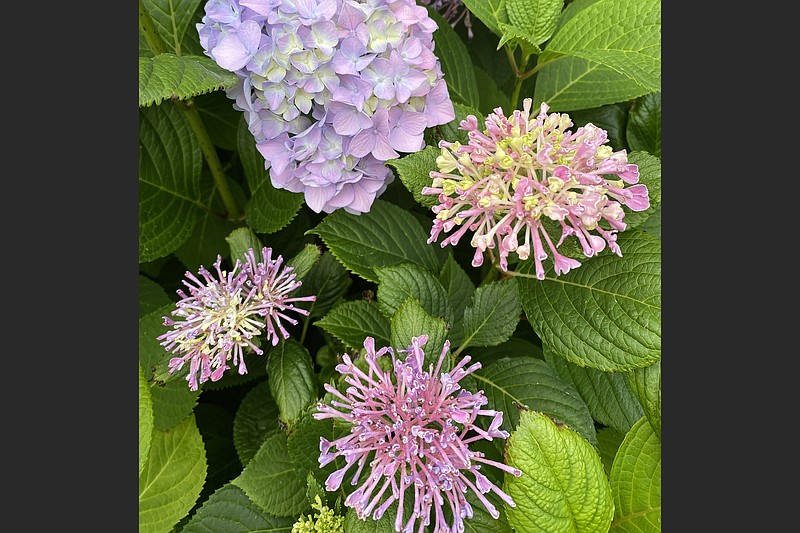Q I have a hydrangea macrophylla plant that has suddenly started producing blooms like none I've ever seen before. The plant is about 7 years old and this year it is producing the normal blooms you'd expect to see but also numerous very different blooms. Any idea what has happened?
A Another reader sent a similar question regarding a hydrangea with mottled foliage, so I am combining the answer. These effects are so interesting and unique — if I didn't think there was a problem, I would want to see more flowers like this.
I believe your hydrangea has a virus, most probably hydrangea chlorotic mottle virus. It is spread from plant to plant by insects, primarily aphids. To be 100% positive, take a sample to your local county extension office for disease diagnosis services. If that is the problem, there is no cure other than destroying the plant before insects transmit the disease to other hydrangeas in the yard.

■ ■ ■
Q In all our years of gardening we have never had something snip off our tomatoes and now our beans. Any suggestions? I have some real stinky manure tea I could pour by the plants to keep whatever it is away. Thank you for any help you can offer.
A An animal of some sort is the culprit. I saw some large deer in my neighborhood this week, and hope they don't discover my yard. You need physical barriers if possible. Use deer fencing if it is deer, small wire frames if it is rabbits. Groundhogs can also do some major damage. Try to figure out what animal you have and then start trying solutions. Nothing is foolproof in animal control.
■ ■ ■
Q Do you know what kind of weed this is in the center of picture? It grew unsolicited and is absolutely beautiful.

A The plant looks like dog fennel (Eupatorium capillifolium). It is a perennial plant that is considered a weed by many. It grows rapidly and will have tiny flowers in late summer until fall that are wind-pollinated. It has an off odor when cut and can be invasive. I like the airy looks of it and do use it in flower arrangements at times, but just be cautious and pay attention to where you have it, as it is opportunistic, and it does grow large.
■ ■ ■
Q Last year I planted a few asparagus crowns and got only bushes. This year the bushes got a lot taller, but still no sign of any asparagus spears. What have I done wrong?

A The asparagus spears begin sprouting from the soil line in March and April. If they are not cut, they then go on to produce the ferny fronds that grow the remainder of the growing season — the bushy growth you have. When in their first two years, we recommend not cutting the spears. Allow them to grow and put energy back into the crowns to make a stronger plant. After they are 3 years and older, you can cut the spears when they reach the height you want (usually 4-6 inches, and before leaves begin to appear) as long as they are thicker in diameter than a pencil. Since you let the fronds grow this year and last, you should have a good harvest next spring, but you will have to be watching, because they will need cutting at least every two days once they begin sending up spears. Once the spears stay small, don't cut: Let them grow to replenish the plant for the following year.
Retired after 38 years with the University of Arkansas Cooperative Extension Service, Janet Carson ranks among Arkansas' best known horticulture experts. Her blog is at arkansasonline.com/planitjanet. Write to her at P.O. Box 2221, Little Rock, AR 72203 or email [email protected]

